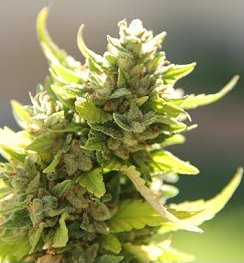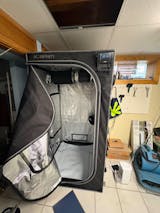Ask 100 growers what grow lights are best for weed, and you'll get 100 different answers.
Ok, maybe 95.
The point is: just about everyone has a different opinion.
But the truth is, there is no single “best grow light.”
The best cannabis lighting is actually a combination of different light sources.
An article from the High Times website titled “Ultimate Lighting” (link removed, article no longer available) describes four lighting setups for differently-sized indoor gardens.
All of the setups use multiple types of lighting and are based on the same principle.
Basic Lighting Principle for Growing Weed
The idea is quite simple, really:
- Hang a high-output, full-spectrum LED or HPS light above the plants
- Hang a lower-output, blue-spectrum light source to the side of the plants.
The plants get most of their light from the overhead HPS or LED light.
This is supplemented by the blue light source, either from an MH bulb, a cold (5500K and up) fluorescent bulb, or an LED equivalent (bar lights like these are excellent for this).
This secondary light source hangs about a third of the way down from the top of the canopy, in the rows between the plants.
The intense light from above feeds the plants and promotes fast growth and strong bud production.
But with only overhead light, especially the reddish light from an HPS bulb, plants tend to grow tall and thin.
This leads to poor production on the lower parts of the plant.
The supplemental blue light encourages thick growth on the lower parts and signals plants to increase bud production further down.
You get the best of both worlds with this marijuana grow light setup.
Red light promotes production of buds and flowers and decreases maturation time, while blue light promotes more leaves, better bud quality and tighter, sturdier growth.
Plus, with overhead-only lighting, the lower parts of the plants are usually looser and less lush than the canopy.
With this setup, the blue light is delivered to an area of the plants where it can have the biggest impact on yield and quality.
Let's look at some of the example setups from the High Times article using this principle:
Marijuana Lighting for a Closet Grow
When growing weed in a tight space like a closet, you want short, bushy growth.
This ensures maximum yields without needing a large number of plants. High quality buds are especially important, since the small space limits potential yield size.
Heat can become problematic in a small grow space, so a high-output LED grow light is your best bet.
Go with a full-spectrum LED panel with an actual wattage of 300 to 600 watts (our recommendation).
It won't be cheap, but you'll save money in the long run and avoid a lot of headaches with heat.
Supplement the LED with blue-spectrum fluorescent bulbs, or equivalent LED bars, hung vertically next to the plant(s). Go with a color temperature of 5500K to 6500K and around 45 watts per bulb.
Fluorescent bulbs will produce some heat, but using an LED for the main light source keeps it manageable. We recommend LED bars instead of fluorescent, to avoid the heat issue altogether and eliminate the need to change bulbs.
Specific Example:
For a 3 by 3 foot grow space, you could use a 600 watt LED fixture above the plants and 4 LED bars, or 4 fluorescent bulbs of 45-60 watts each, hung around the sides.
This 2 foot, 24 watt veg/clone bar is ideal. It costs more than a fluorescent bulb, but ends up saving you a lot in the long run, due to lower power usage and no bulb changes.
If you prefer fluorescent bulbs, you can get them at any department or hardware store or online at Amazon (here's a good, cheap bulb, for example).
You could even switch the colder (5500K to 6500K) bulbs for warmer ones (around 2700K) for the last two weeks of flowering to really ramp up production. The best LED bar for that is this 24 watt bloom bar.
You're going to want to keep the grow contained inside the closet, so a grow tent might be a good idea.
To keep costs down, but still ensure quality, go with the entry-level Secret Jardin Hydro Shoot tent (link goes to the 3x3). For a higher quality option, try the professional-grade Dark Room (also 3x3).
Lighting to Maximize Yield When Growing in a Spare Room
If you are growing in a spare room, space is generally still limited, but you have a lot more of it available than you would growing in a closet.
Isolating your grow from the surroundings is even more important. Find a good grow tent that is large enough for your plants, but make sure it fits inside your room.
Growing in a tent, you'll need to ensure it is well-ventilated.
To help minimize heat, I'd recommend going with LEDs again for the overhead lights. They'll also give you higher potency, which is a good way to make up for a smaller grow space that limits your potential yield size.
Specific Example:
Go with one Grower's Choice ROI-E720 grow light for every 12 to 16 square feet or one NextLight Core for every 4 to 9 square feet.
Hang LED bars or fluorescent bulbs between the plants as before, but bump up the power. Use two of the 24 watt bars (or the larger 42 watt, 4 foot bars to cover twice the space) instead of one or use 125 watt to 250 watt fluorescent bulbs.
LED is preferable, because they use less power and generate less heat. Fluorescent grow lights this powerful actually produce a lot of heat, but they are still much safer to use inside a prefabricated grow tent than bare HID bulbs.
Use mostly blue-spectrum bars or bulbs, but feel free to add in some red-spectrum bars or bulbs as well, especially toward the last two weeks of the grow cycle.
Medical Growers With Strict Plant Count Limits
When you have a limited number of cannabis plants to work with, you want to maximize the growth and yield of each plant.
To achieve this, put each plant in a large 20-gallon pot and give it its own NextLight Mega Pro (or 1000-watt HPS grow light) to feed it from above.
Supplement this with bare (no reflector) 400 watt MH bulbs (remember, you need a ballast for each bulb) hanging vertically where the rows between the plants cross (I.e. one bulb hanging equidistant from four plants).
To make it easier, we have bundled together a kit that includes the socket, a bulb of your choice, and a high-quality mini ballast.
For example, six plants would mean six 1000-watt HPS lights and two 400-watt MH bulbs. The following image tries to show this:

(yeah, I know….I should have hired a designer...or my 4 year old nephew….)
When High Times used this setup, they got great yields with amazing crop quality from top to bottom. The bud cycle finished a full week earlier than the same genetics did with a more conventional lighting system.
Obviously, there's one major drawback. A setup like this will generate a ridiculous amount of heat.
Use air-cooled reflectors to keep the majority of the heat from the HPS lights from entering your grow space (or just use LED lights).
Make sure the rest of the space is ventilated well enough that the MH bulbs don't raise the temperature above 85 degrees.
This setup gives you over 65 watts per square foot of growing space.
That's more than double the standard recommended amount (30 watts per square foot), so you could easily use smaller lights and grow smaller plants with the same system.
Naturally, you could also go even bigger. Just make sure you keep the heat in check.
Getting Maximum Production From Your Grow Space
This setup takes the previous one to the next level.
Wide beds are used to give each plant a 5 by 5 foot area with plenty of space at the roots. Above each plant hangs a NextLight Mega Pro (or a 1000-watt HPS light in a large reflector, air-cooled ideally).
The sides of the plants are illuminated by 600 watt HID bulbs hanging bare between the plants, with one bulb beside each plant. Remember that you need a ballast for each bulb. Check out our kits that include everything you need (socket, bulb, ballast).
For maximum production, use a MH bulb during veg and through the early part of the flowering cycle. Then switch to HPS in the final stages, once the plants have stopped vertical growth and are entering the peak bud phase.
Assuming plenty of space for the roots to grow, good air quality, and good nutrition, your plants will grow enormously with this type of weed grow light setup.
Be prepared to adjust plant spacing and veg times as needed and make sure you keep the temperature under control. Use a high-temp kill switch to guard against disaster in the event of a cooling system failure.
Obviously, if you're a beginning grower, these last two examples are a bit “out there”, but I thought it would be interesting to include them anyway. But the basic principle is easily duplicated for any size grow:
- Use a strong light overhead, either full-spectrum LED or HPS
- Supplement with blue-spectrum side lighting, either fluorescents or metal halide
- Optionally, switch to red-spectrum side lighting for the final stages
Give it a try for your next grow and let us know what kind of results you get.
We'd also like to hear about the types of lighting setups you use and have found especially effective (or those you've found less effective). Let us know in the comments below!
Check out our Grow Tent Comparison Table to quickly compare sizes, features, and pricing across top brands!










Comments
Leave a comment